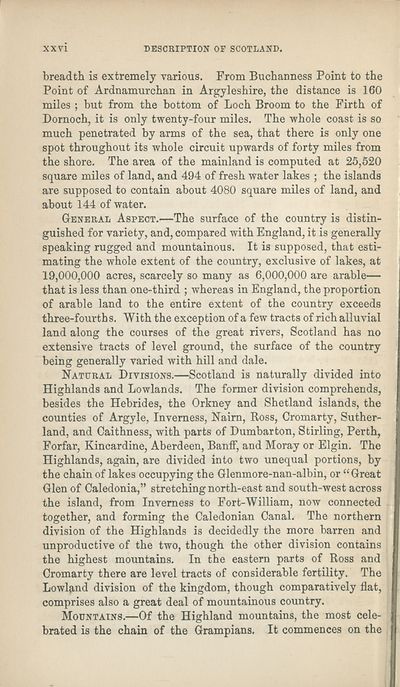Download files
Complete book:
Individual page:
Thumbnail gallery: Grid view | List view

xxvi
DESCRIPTION OP SCOTLAND.
breadth is extremely various. From Buchanness Point to the
Point of Ardnamurchan in Argyleshire, the distance is 160
miles ; but from the bottom of Loch Broom to the Firth of
Dornoch, it is only twenty-four miles. The whole coast is so
much penetrated by arms of the sea, that there is only one
spot throughout its whole circuit upwards of forty miles from
the shore. The area of the mainland is computed at 25,520
square miles of land, and 494 of fresh water lakes ; the islands
are supposed to contain about 4080 square miles of land, and
about 144 of water.
General Aspect.—The surface of the country is distin¬
guished for variety, and, compared with England, it is generally
speaking rugged and mountainous. It is supposed, that esti¬
mating the whole extent of the country, exclusive of lakes, at
19,000,000 acres, scarcely so many as 6,000,000 are arable—
that is less than one-third ; whereas in England, the proportion
of arable land to the entire extent of the country exceeds
three-fourths. With the exception of a few tracts of richalluvial
land along the courses of the great rivers, Scotland has no
extensive tracts of level ground, the surface of the country
being generally varied with hill and dale.
Natural Divisions.—Scotland is naturally divided into
Highlands and Lowlands. The former division comprehends,
besides the Hebrides, the Orkney and Shetland islands, the
counties of Argyle, Inverness, Naim, Ross, Cromarty, Suther¬
land, and Caithness, with parts of Dumbarton, Stirling, Perth,
Forfar, Kincardine, Aberdeen, Banff, and Moray or Elgin. The
Highlands, again, are divided into two unequal portions, by
the chain of lakes occupying the Glenmore-nan-albin, or “Great
Glen of Caledonia,” stretching north-east and south-west across
the island, from Inverness to Fort-William, now connected
together, and forming the Caledonian Canal. The northern
division of the Highlands is decidedly the more barren and
unproductive of the two, though the other division contains
the highest mountains. In the eastern parts of Ross and
Cromarty there are level tracts of considerable fertility. The
Lowland division of the kingdom, though comparatively flat,
comprises also a great deal of mountainous country.
Mountains.—Of the Highland mountains, the most cele¬
brated is the chain of the Grampians. It commences on the
DESCRIPTION OP SCOTLAND.
breadth is extremely various. From Buchanness Point to the
Point of Ardnamurchan in Argyleshire, the distance is 160
miles ; but from the bottom of Loch Broom to the Firth of
Dornoch, it is only twenty-four miles. The whole coast is so
much penetrated by arms of the sea, that there is only one
spot throughout its whole circuit upwards of forty miles from
the shore. The area of the mainland is computed at 25,520
square miles of land, and 494 of fresh water lakes ; the islands
are supposed to contain about 4080 square miles of land, and
about 144 of water.
General Aspect.—The surface of the country is distin¬
guished for variety, and, compared with England, it is generally
speaking rugged and mountainous. It is supposed, that esti¬
mating the whole extent of the country, exclusive of lakes, at
19,000,000 acres, scarcely so many as 6,000,000 are arable—
that is less than one-third ; whereas in England, the proportion
of arable land to the entire extent of the country exceeds
three-fourths. With the exception of a few tracts of richalluvial
land along the courses of the great rivers, Scotland has no
extensive tracts of level ground, the surface of the country
being generally varied with hill and dale.
Natural Divisions.—Scotland is naturally divided into
Highlands and Lowlands. The former division comprehends,
besides the Hebrides, the Orkney and Shetland islands, the
counties of Argyle, Inverness, Naim, Ross, Cromarty, Suther¬
land, and Caithness, with parts of Dumbarton, Stirling, Perth,
Forfar, Kincardine, Aberdeen, Banff, and Moray or Elgin. The
Highlands, again, are divided into two unequal portions, by
the chain of lakes occupying the Glenmore-nan-albin, or “Great
Glen of Caledonia,” stretching north-east and south-west across
the island, from Inverness to Fort-William, now connected
together, and forming the Caledonian Canal. The northern
division of the Highlands is decidedly the more barren and
unproductive of the two, though the other division contains
the highest mountains. In the eastern parts of Ross and
Cromarty there are level tracts of considerable fertility. The
Lowland division of the kingdom, though comparatively flat,
comprises also a great deal of mountainous country.
Mountains.—Of the Highland mountains, the most cele¬
brated is the chain of the Grampians. It commences on the
Set display mode to:
![]() Universal Viewer |
Universal Viewer | ![]() Mirador |
Large image | Transcription
Mirador |
Large image | Transcription
| Antiquarian books of Scotland > Scotland/Scots > Black's picturesque tourist of Scotland > (32) |
|---|
| Permanent URL | https://digital.nls.uk/130028574 |
|---|
| Description | Thousands of printed books from the Antiquarian Books of Scotland collection which dates from 1641 to the 1980s. The collection consists of 14,800 books which were published in Scotland or have a Scottish connection, e.g. through the author, printer or owner. Subjects covered include sport, education, diseases, adventure, occupations, Jacobites, politics and religion. Among the 29 languages represented are English, Gaelic, Italian, French, Russian and Swedish. |
|---|

